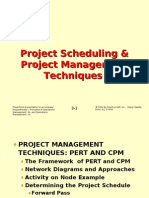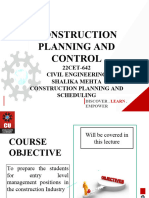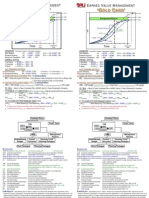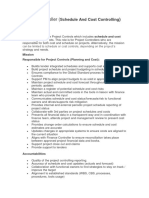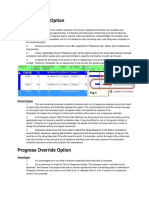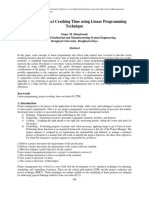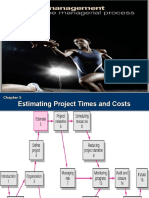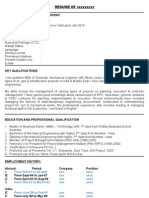Project Control PDF
Project Control PDF
Uploaded by
Agung A BaktiCopyright:
Available Formats
Project Control PDF
Project Control PDF
Uploaded by
Agung A BaktiOriginal Description:
Original Title
Copyright
Available Formats
Share this document
Did you find this document useful?
Is this content inappropriate?
Copyright:
Available Formats
Project Control PDF
Project Control PDF
Uploaded by
Agung A BaktiCopyright:
Available Formats
Dale R.
Labitzke, PE
Professional Chemical Engineering
http://www.born2process.com
PLANNING, SCHEDULING & PROJECT CONTROL
THE AIM OF PLANNING, SCHEDULING AND CONTROL
The completion date of a project is known. It is the market driven date conveyed
to the Project Manger and Task force by the Owner. Planning, scheduling, and
control is the art of preparing a plan that meets the completion date, scheduling
the individual tasks to support the plan, and reporting progress against schedule.
The aim of planning, scheduling and control is to show the Project Manager at all
times:
1. Precisely where the work stands, and where it should stand.
2. When delays occur, what must be done to offset them.
3. The cost of correcting delays, compared to the cost of drag-out that will
otherwise accrue.
4. The impact of delays and difficulties which occur on project completion,
start-up, production and the Owner's return on investment
5. The earliest practicable time that project completion and start-up can be
expected, if all goes well.
The terms "planning", "scheduling" will be encountered frequently. As applied to
Engineering and Construction projects:
1. "Planning" means determining what work must be done to achieve the
project objective and the relationships between the various activities.
2. "Scheduling" means deciding when the various activities will be carried
out.
3. "Control" means making full use of the tools provided by the scheduling
and monitoring operations and refers to the process of analyzing data,
investigating causes of backlog, determining solutions, comparing the cost
of these drag-out costs, and preparing specific recommendations to the
Project Manager.
Practical results of project control range from detecting errors in planning to
achieving better control over revisions in the engineer's shop, re-allocating
manpower from low priority to high priority tasks, pinpointing inadequate
supervision, inefficient labor, and approval bottlenecks, and eliminating effects of
delays on project completion. Control is the principle function of the Project
Controller, his planning, scheduling and measurement of progress being the
means by which he creates data necessary for the control function.
The presence of a Project Controller on a project does not in any way relieve any
individual Task Force member from the responsibility for planning day-to-day
work. This includes the assignment of tasks, the preparation of documents, the
detail preparations leading to efficient execution, inspection and review, all
directed towards the goals defined for his unit in the project schedule.
CONTINGENCIES
Under our method of project management, the Owner holds both the schedule
contingency and budget contingency in reserve. If problems are encountered,
the Project Manager informs the Owner of the problem, requests the use of
contingency, and justifies use of contingency over any other alternative.
PRELIMINARY PLAN AND SCHEDULE
It is assumed that a preliminary plan and schedule was prepared in the course of
defining the project for appropriation and are available as reference for detailed
project planning and control.
PROJ ECT DEFINITION
Usually the first planning task that confronts the Task force when starting a newly
funded project is to prepare a Project Definition. The purpose of the Project
Definition is:
1. To create common understanding and agreement among all concerned
regarding:
a. The project objective.
b. The principal tasks, operations and activities, which together must
be accomplished by the Task Force, by the Owner, and by others,
to achieve the objective.
c. The relationships between these activities and their effect on each
other and on the whole project.
d. The urgency of completion for the whole project and for each of its
components.
e. The division of responsibility for execution of various portions of the
project between the Task Force, the user Owner, and others.
2. To act as reference as to scope of work for that portion of the project
assigned to the Task Force and to control escalation (scope creep).
3. To establish in general terms the magnitude of the Task forces portion of
the work by describing the nature and extent of the engineering,
procurement, and construction work involved, and by pinpointing unusual
problems, limitations, major unresolved questions, and decisions
outstanding.
4. To act as the basis for the preliminary timetables, planning plan, detailed
planning, and reporting
To facilitate control, the project is divided into areas or portions based on
functional significance. Each portion or area is planned, scheduled and controlled
as a complete functional entity; each area must include the utilities, access
routes and other facilities needed to make it operable or useful as a functional
entity.
PLANNING PLAN, SCHEDULE AND BUDGET
On larger projects based on the number of areas to receive detailed attention
and the broad timings reflected in the Owners schedule, the Project Controller
prepares a Planning Plan and Timetable showing when detailed planning for
each area will take place and what additional assistance he will need for this. A
simple planning budget follows, based on salaries, expenses, data processing
and drafting assistance needed, supplies, etc. called for by the Planning Plan.
SOFTWARE AND PLANNING
The use of software to facilitate this function is strongly encouraged. At the time
of this writing, Primavera, Timberline, and MS Project Manager are known to be
comprehensive and easy to use software. Software is used to eliminate some of
the drudgery in planning operations. We recommend the software be used
generally as follows:
1. The project is broken down into functional areas and team agreement
obtained.
a. A network diagram is produced to describe the detailed steps
required to complete each functional area and team agreement
obtained.
b. Estimated work effort, estimated task duration, and resources
assigned to every step in every functional area and team
agreement obtained.
c. The network diagrams are then linked together at the most logical
points to form the project diagram
d. The project network diagram is converted to a project Gantt chart.
e. Resource leveling is applied and the completion date generated.
The completion date will probably be unacceptable.
2. At this point the Task Force has to decide how to manipulate the plan to:
a. Those areas that can generate an early revenue stream for the
Owner are scheduled early to take full benefit of any early revenue
stream.
b. Those areas that provide no benefit until the entire project is
complete are scheduled late, to avoid premature commitment of
funds.
c. Review for over design, gold plating, or padding that can be
eliminated.
d. Add or change resources to reduce the project completion date to
an acceptable time.
Once this work has been completed, reviewed, agreed, and approved, the results
should be printed and published, and the software turned off. We recommend
against using the reporting features of the software. We do not believe in the
value added system of reporting progress. The temptation to change the
schedule to reduce schedule pressure is very great and must not be allowed.
ENGINEERING, PURCHASING; CONSTRUCTION AND PLANNING
PRIORITIES
Engineering, Purchasing, and Construction Priorities
Where several areas are scheduled for concurrent execution, every effort should
be made to pursue them with equal vigor. However, if at any time the available
resources are insufficient to pursue all areas concurrently, the available
resources are concentrated on the higher priority areas at the expense of the
lower priority areas. Priorities are worked out from the Project Schedule by
comparing the relative value to the Owner of each of the various areas if
completed. In the case of those areas scheduled late due to negative return, they
are compared on the basis of the cost of premature commitment of funds, and
the impact on the whole project should any of the various areas run over the
scheduled completion time.
Planning Priorities
Planning priorities on the other hand are determined on the basis of the relative
value to the Owner in controlling project and area execution, of applying detailed
planning and monitoring measures to the various areas. In other words, detailed
planning measures are applied where it appears they will do the most good.
Where it is clear that they will exert little influence on control of the project, only
very broad planning and scheduling measures are applied.
ENGINEERING TIMETABLES
It should be recognized that the preparation of design transmittals and drawing
lists might be occurring at the same time as the detailed project planning.
Engineering will be one of the first collections of area tasks to be scheduled.
Engineering Timetables are generated from the software on an area-by-area
basis, starting with the highest priority area. It is an important to prepare these
timetables as quickly as possible so as to have engineering under measurement
at the earliest possible moment. It is important that the Project Manager
participate directly in seeing that the Engineering Timetable is prepared properly
and without delay. In particular, he must ensure that the Architect-Engineer's job
captains or equivalent are used to prepare the lists of design transmittals,
specifications and drawings, and that they are not side-tracked elsewhere until
this work has been completed. He must ensure that all concerned face the
problem of defining the engineering work head on, and that whatever time is
needed to think out each list thoroughly and in detail, is devoted to this task. The
aim is to create the final, complete drawing list at the outset, with the final
drawing titles, so that no further revision will be necessary throughout the project.
As soon as the Engineering Timetable has been prepared for a given area,
measurement of progress should start and weekly progress reports should be
distributed to all concerned, including the Architect-Engineer. It is important that
the Architect-Engineer and the Engineering Coordinator execute their work in
accordance with the established priorities.
ENGINEERING MANPOWER ESTIMATES
Engineering manpower estimates required for the engineering budget are
prepared in two portions as follows:
1. Manpower required for scheduled engineering. This is derived directly
from the Engineering Timetable by converting the tasks shown thereon to
men in the various disciplines and categories and by converting results to
man-hours.
2. Non-scheduled engineering. This is accounted for separately by discipline
and category by estimating the man-hours for voided work and revised
work plus delays in engineering and engineering assistance that has been
requested by the Task Force.
PURCHASING TIMETABLES
Purchasing timetables are usually prepared in conjunction with engineering
timetables on an area-by-area basis. They reflect inquires, quotations, bid
evaluations, and preparation of purchase orders and contracts. Purchasing
timetables give valuable advance information as to the purchasing manpower
that will be needed during peak periods.
SCHEDULING VENDOR WORK
While there are many cases in which the vendors delivery promises are
acceptable, for key items where a delivery delay will jeopardize the project
schedule it is mandatory for the Project controller to go into the vendors shop
and schedule his work using the concepts outlined above. Where this is the
case, the Task Forces intention to provide schedule assistance must be clearly
stated in the inquiry and the vendors quotation must be evaluated in light of his
willingness to cooperate. As soon as a vendor selection has been made the
Project controller should prepare a detailed timetable for the vendors
engineering, procurement, fabrication, assembly, test, and preparation for
shipment and should set up a system of measuring the vendors progress.
CONSTRUCTION TIMETABLES
These are prepared on an area-by-area basis immediately following the
engineering timetables. The degree of detail will depend on the degree of
urgency for the particular area or portion in question; for high priority areas the
construction timetable should be in considerable detail. Construction timetables
are prepared following the usual sequence of identifying the work and
establishing the relationship between the various tasks, and estimating the time
required for each task (this usually originates with the Construction Manager but
the Project Control Engineer and the Project Manager must satisfy themselves
that they are realistic and contain no padding). Following this the construction
network is melded with the corresponding engineering network and a network
calculation is made. The resultant network is then "massaged" by examining
each critical and near-critical task and shortening its planned duration wherever
practicable. The resultant network is then incompressible in that it is either
impossible or impracticable to complete the work involved in less time, even
under ideal conditions.
Following the massaging step and establishment of the final network length, the
Project Control Engineer recalculates the entire network to determine individual
task boundaries. He then carries out scheduling and leveling adjustments within
these boundaries and. follows this with a detailed feasibility study of the
congestion, interference, manpower and equipment availability, weather, etc.
problems. Some further adjustment may be necessary.
On completion of feasibility checks a final Construction Timetable is prepared
showing the construction logic on a time-scale basis. This is reviewed by the
Construction Manager, by the Project Manager, and by the Owner. Upon
approval, it is distributed to those concerned.
The Construction Timetable is never changed throughout the project unless the
scope of the project changes.
SCHEDULING START-UP OPERATIONS
Where the task force has responsibility for managing start-up operations, these
operations are scheduled in the normal manner.
PROGRESS REPORTS
Progress reports are prepared each week showing work completed against work
units scheduled and, where this shows a backlog, the reasons for the backlog,
what .is being done to offset it, whether the project length is affected, and the
assistance, if any, being requested from headquarters. We suggest that weekly
reports be prepared Friday mornings and reflect work completed up to the end of
Thursday. Reports should be submitted to the Project Manger before noon
Friday. Reports are prepared by the Project Controller as a service to the Project
Manager. The Project Manager is responsible for ensuring that they are factual,
meaningful, clearly understandable, and withhold no important information.
Measurement of Progress
Work progress is measured, not on the basis of hours spent or work
accomplished, but on the basis of the estimated time remaining to
complete each task. Should this estimate equal or exceed the original estimate,
no credit for physical progress is given. The Architect-Engineer, vendor or
contractor providing he is properly instructed in this method of measurement can
carry out actual measurement. The Project Controller is responsible for frequent
spot-checks to satisfy himself that the progress reported is valid. Physical
progress is compared with scheduled progress and actual manpower with
scheduled manpower. Any inconsistency is the subject of careful investigation by
the Project Controller.
Work Sampling
From time to time, particularly as each new phase of work commences, the
Project Controller must carry out detailed work sampling, to test the validity of
original duration estimates and of the progress reported. Where this shows a
definite pattern of incompatibility with the original estimates, major adjustments
may be required which will necessitate recalculation of earliest practicable
completion date.
Follow-up Action
The Project Manager must realize that the end result of the planning, scheduling
and control is recommendations based on analysis. These are pointless without
corresponding follow-up action, and the latter is the responsibility of the Project
Manager.
PROJ ECTIONS
From time to time it may be necessary to carry out projections of the project
schedule, based on the work remaining to be done, when it is obvious that the
completion date originally calculated will not be met. It is important to understand
that these projections are merely recalculations based on updated information in
the light of what has passed. They are not predictions of actual completion, but
are statements of the earliest practicable completion date based on the current
situations
You might also like
- Formula Sheet - CCP ExaminationDocument1 pageFormula Sheet - CCP Examinationrafeh khattakNo ratings yet
- Schedule Baseline NarrativeDocument2 pagesSchedule Baseline NarrativeIrwan Kurniawan100% (5)
- Introduction To Project Control 1Document14 pagesIntroduction To Project Control 1Samir Chury100% (1)
- Planning & Scheduling RulesDocument4 pagesPlanning & Scheduling RulesCampjojoNo ratings yet
- Construction Project Planning and Scheduling L4Document10 pagesConstruction Project Planning and Scheduling L4Mel'aku Gebr'elNo ratings yet
- Schedule LevelsDocument15 pagesSchedule LevelsKHMHNNo ratings yet
- Primavera Interview Questions & Answers: (Type Text)Document4 pagesPrimavera Interview Questions & Answers: (Type Text)AMMAR MAWNo ratings yet
- 14 Steps To Create Cash Flow FRDocument14 pages14 Steps To Create Cash Flow FRshareyhou100% (2)
- Schedule Delays in Engineering, Procurement, and Construction Petrochemical Projects in Vietnam A Qualitative Research StudyDocument25 pagesSchedule Delays in Engineering, Procurement, and Construction Petrochemical Projects in Vietnam A Qualitative Research StudyHaytham S. Atia100% (1)
- Planning and Scheduling - Chapter-3Document62 pagesPlanning and Scheduling - Chapter-3Mekuannint DemekeNo ratings yet
- DelayQuantumProject AdvisoryDocument15 pagesDelayQuantumProject AdvisoryNgumisirize FredrickNo ratings yet
- Negative FloatDocument5 pagesNegative Floatroyal3311No ratings yet
- Good Scheduling Practice PDFDocument15 pagesGood Scheduling Practice PDFLamoniely NascimentoNo ratings yet
- Resume For The Post of Project, Planning EngineerDocument5 pagesResume For The Post of Project, Planning Engineerssbapi33% (3)
- Project Scheduling and Network TechniquesDocument39 pagesProject Scheduling and Network TechniquesapiconpikkNo ratings yet
- Group 6 & 7 - Planning and SchedulingDocument122 pagesGroup 6 & 7 - Planning and SchedulingPercival ArcherNo ratings yet
- Shutdown ScheduleDocument31 pagesShutdown Schedulewaqas khanNo ratings yet
- Planning and SchedulingDocument22 pagesPlanning and SchedulingAsif KhanNo ratings yet
- CH 5 - Project Management and Resource AllocationDocument86 pagesCH 5 - Project Management and Resource AllocationFikiru DubaNo ratings yet
- Earned Value Management Gold CardDocument2 pagesEarned Value Management Gold CardDaniel Rué MayolasNo ratings yet
- Project SchedulingDocument22 pagesProject SchedulingKunjal Kumar SinghNo ratings yet
- Project Controller (: Schedule and Cost ControllingDocument5 pagesProject Controller (: Schedule and Cost ControllinghichemokokNo ratings yet
- PSP P-2Document15 pagesPSP P-2Deejaay2010100% (1)
- General Revision 1Document28 pagesGeneral Revision 1Deejaay2010No ratings yet
- EVM Implementation PDFDocument83 pagesEVM Implementation PDFdanish_1985No ratings yet
- Primavera Cost LoadingDocument5 pagesPrimavera Cost LoadingGerry TriazNo ratings yet
- Measuring Project Progress - 6 Methods You Should KnowDocument10 pagesMeasuring Project Progress - 6 Methods You Should KnowI Kailash Rao100% (1)
- Project Control ToolsDocument24 pagesProject Control Toolssrsureshrajan100% (1)
- Retained Logic OptionDocument15 pagesRetained Logic Optionsharad kumarNo ratings yet
- Crashing Time Scheduling ProblemDocument9 pagesCrashing Time Scheduling ProblemeragornNo ratings yet
- S CurveDocument5 pagesS CurveAnonymous cQ13WWe100% (2)
- Interview Questions For A Planning Engineer: July 25, 2019 / Primavera P6 / 18 CommentsDocument8 pagesInterview Questions For A Planning Engineer: July 25, 2019 / Primavera P6 / 18 CommentsSAADINo ratings yet
- Applying Learning Curve Theory in Construction Cost EstimatingDocument5 pagesApplying Learning Curve Theory in Construction Cost EstimatingayaznptiNo ratings yet
- Project Engineer & Planning Interview QuestionsDocument7 pagesProject Engineer & Planning Interview QuestionsAnonymous E2oSW7No ratings yet
- Article #110 Using Earned Value Management To Monitor, Evaluate and Report Resources Efficiency Involved in Delivering Capital ProjectsDocument6 pagesArticle #110 Using Earned Value Management To Monitor, Evaluate and Report Resources Efficiency Involved in Delivering Capital Projectsshajbaby100% (1)
- Project Control Using EVMDocument40 pagesProject Control Using EVMAbdul NaseerNo ratings yet
- Front End Engineering Design or FEED (PDF) - What Is Piping - All About Piping EngineeringDocument11 pagesFront End Engineering Design or FEED (PDF) - What Is Piping - All About Piping Engineeringdriveamar21No ratings yet
- Cepsiab Sample For Web 2021Document37 pagesCepsiab Sample For Web 2021CCENo ratings yet
- Cause & Effect of EOTDocument4 pagesCause & Effect of EOTRic S. MalongaNo ratings yet
- Project Cost Control Jul 02Document23 pagesProject Cost Control Jul 02Dexter DuronNo ratings yet
- What To Do When Preparing A Project ScheduleDocument2 pagesWhat To Do When Preparing A Project ScheduleCristian Steven SilvaNo ratings yet
- Steps in Construction SchedulingDocument6 pagesSteps in Construction SchedulingBandar AlshammariNo ratings yet
- Job Description Construction Cost ManagerDocument3 pagesJob Description Construction Cost ManagerTRIUMPH50000100% (1)
- Cost ContingenciesDocument14 pagesCost ContingenciesbokocinoNo ratings yet
- Earned ValueDocument17 pagesEarned ValueBlanche PhlaumNo ratings yet
- Chap005 Estimating Time & CostDocument35 pagesChap005 Estimating Time & CostWaqas Khan100% (1)
- PS.1691 Calculating The As-Built Critical Path: Andrew Avalon, PE PSPDocument19 pagesPS.1691 Calculating The As-Built Critical Path: Andrew Avalon, PE PSPfaaderinto5964100% (1)
- Schedule Narrative Report - BaselineDocument1 pageSchedule Narrative Report - BaselinemohammednatiqNo ratings yet
- Chapter 10 PDFDocument30 pagesChapter 10 PDFPandaNo ratings yet
- Contract Workshop - CICES-PCE 06-07-2010Document72 pagesContract Workshop - CICES-PCE 06-07-2010Fatmah Ashraf ElwardagyNo ratings yet
- S Curve ModellingDocument8 pagesS Curve Modellingrasputin0780803494100% (1)
- SAMPLE CV Project Control Engr - 18years - XXXXDocument7 pagesSAMPLE CV Project Control Engr - 18years - XXXXWilly Wao ToronNo ratings yet














